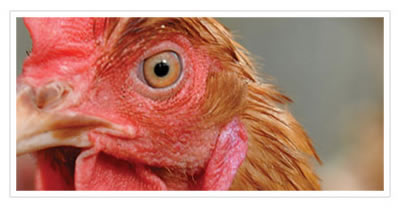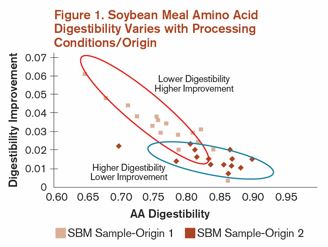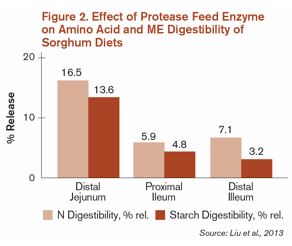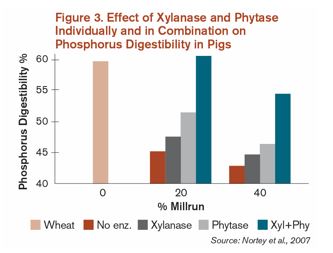



Supporting Sustainable Animal Production with Feed Enzymes
Simply stated, a growing human population means an increasing demand for food, and animal protein will make up a large part of meeting this increasing demand, writes Dr. Ajay Bhoyar – Senior Manager, Global Poultry Marketing, Novus International, Inc.All protein sources will have to increase production, but out of every protein source on the market, poultry and swine will see the largest increase. Aquaculture and ruminant growth will also occur, but on a smaller scale than that of poultry and swine. A rise in demand for animal protein calls for an increase in demand for animal feed, and a trend is developing where coproducts and byproducts are being incorporated into monogastric feeds at levels not seen before this millennium.
 Because price is a leading factor of feed inputs, utilization of alternative feed ingredients is expected to grow. Most of these alternative feed ingredients contain various forms and different levels of anti-nutritional factors (ANFs), which reduce efficiency of nutrient absorption and, in turn, animal production. Unless these ingredients are made more conducive for animals to digest, both animal production efficiency and environmental management face significant challenges.
Because price is a leading factor of feed inputs, utilization of alternative feed ingredients is expected to grow. Most of these alternative feed ingredients contain various forms and different levels of anti-nutritional factors (ANFs), which reduce efficiency of nutrient absorption and, in turn, animal production. Unless these ingredients are made more conducive for animals to digest, both animal production efficiency and environmental management face significant challenges.
Enzymes have the ability to serve as an agent to reduce effects of ANFs by naturally breaking down hard-to-digest components that would otherwise be wasted. This action releases more nutrients with less waste and subsequently allows lower inclusion levels of costly ingredients in the feed.
Enzymes will act on their particular substrates and will exhibit full results, whether used independently or in combination. When used in combination, additional benefits may be seen beyond energy, mineral and individual amino acid release. Phytase, xylanase and protease are three popular feed enzymes used in the animal industry today. These enzymes are integral to digestion as they act on specific substrates present in all raw materials, even when alternative feed ingredients are not used.
Reducing Environmental Impact with Phytase
Phytate stores phosphorus (P) during seed germination and protects against oxidative stress during the life of the seed. One issue with the presence of phytate-P in the feed of monogastric animals is that undigested P is excreted and creates an environmental hazard. Alternative sources of P include meat and bone meal, in which P is highly digestible. Releasing P from phytate using a phytase enzyme reduces environmental load and also reduces cost of feed, as other sources of P are required at lower levels.
Additionally, phytate chelates other minerals, such as Zn, Cu, Ca and Fe, reducing the availability of these minerals. Phytate also has the capacity to bind protein, which in turn may depress amino acid digestibility. In poultry, phytate depresses energy utilization as well.
Phytase is active in the gizzard and proventriculus of poultry. In swine, the main site of activity is the stomach. The newest generation of phytases will likely complete their activity in the acidic environment of the stomach.
Initial development of bacterial phytases raised the level of bioefficacy in animal feed. The latest generation phytases offer further improvement as indicated by their higher matrix values, which are highly dependent on ingredients and test conditions. At the same time, more benefits may be ascribed to phytase and reveal further value to the producer as more is understood of its mode of action.
Increasing Potential Nutrient Absorption with Xylanase
Non-starch polysaccharides (NSPs) belong to a group of carbohydrates referred to as dietary fiber. NSPs are poorly digested in the small intestine, but are completely or partially digested by microbes, which produce short chain fatty acids that may be absorbed from the small or large intestine as a result of fermentation.
Higher levels of insoluble fiber, found in wheat byproducts and coproducts, such as corn- or wheat-based Dried Distillers Grain Solubles (DDGS), speed passage of nutrients through the gut thereby reducing potential for absorption. Xylanase alleviates this effect and permits the greater use of raw materials with lower nutritional value, thereby increasing the flexibility of feed formulation and reducing feed cost.
In poultry, xylanase activity occurs mainly in the small intestine, although some activity in the crop is possible depending on the feeding regimen. In swine, the stomach has potential as an important site of activity. Therefore, some or all of the activity of xylanase and phytase could be in the same region in swine.
Supporting Feed Ingredient Variation with Protease
Soybean meal, a popular source of protein for livestock and aquaculture, has a high concentration of protein, which is highly digestible and well balanced for non-ruminants. However, quality varies from region to region. Soybeans contain ANFs, which are known to depress growth performance in swine. Other vegetable protein sources also have a combination of both valuable available amino acids and undesirable ANFs.
Protease can potentially show multiple benefits. It reduces effects of the ANFs described above. Consequently, it lowers the risk associated with poorly balanced feed formulation and variation in nutritional quality of feed ingredients (Figure 1). Protease also allows for use of poorer quality raw materials at higher inclusion rates. Finally, it allows for a lower protein level of the diet and reduces overall feed cost.
One enzyme may have multiple nutrient benefits beyond its primary action. Protease, for example, breaks down the protein complex protecting the starch granule in sorghum, which has the additional benefit of releasing energy indirectly for use by the animal. Therefore, although there will be improved amino acid digestibility values for protease with sorghum, the full energy value will be significantly higher due to secondary effects (Figure 2).
Protease is commonly more active in the small intestine. There is potential for overlap in its activity with phytase and xylanase in the proximal duodenum, but protease activity could continue even after phytase and xylanase have become inactive. Protease and amylase activity also could overlap, which may be beneficial for certain feed ingredients.
Maximizing Potential with Multiple Enzymes
All raw materials contain a combination of ANFs coming from fiber, phytate and protease-sensitive factors. Much of the P in corn is bound to phytate, but can be released with the addition of phytase. Corn also has levels of insoluble NSP that may be broken down by xylanase. Corn- or wheat- based DDGS have high levels of NSP that show increased value with xylanase inclusion. Soy nutritional value benefits from phytate breakdown with phytase, fiber degradation from xylanase and the improved protein digestibility due to ANF reduction from protease supplementation.
Accordingly, the mode of action of each enzyme may be synergistic with that of others. Including multiple enzymes brings more nutrient release and greater reduction of ANF effects of the diet than may be achieved with a single enzyme. Nortey et al. (2007), showed phosphorus digestibility was improved by adding either phytase or xylanase, but was greatest when both enzymes were combined in a wheat-based diet (Figure 3). This work also showed phytase and xylanase improved intestinal energy and lysine digestibility. This illustrates how multiple enzymes may show levels of improvements on individual nutrients beyond their primary action.
The modes of action of phytase, xylanase and protease are complementary and should provide more consistent results across species. Additionally, responses will be stronger where raw material quality is poor or variable.
Looking to the Future
Satisfying the need for food is something that cannot be overlooked. As production costs increase and readily available resources decrease, it is increasingly important to re-evaluate animal feed options. Improved utilization of available feed ingredients will be instrumental to satisfy the growing global demand for protein. When looking at feed options, the use of enzymes has emerged as an important contribution toward a solution for increased sustainable animal production.
These enzymes help increase the bioavailability of costly nutrients, decrease excess nutrient excretion into the environment and improve animal performance. With the addition of enzymes, ANFs are no longer compromising the gut health of animals because the enzymes work to break them down effectively for absorption into the body.
Raw material options for feed are limited. However, the development in technology and application of enzymes thus far is only scratching the surface. The animal production industry can look to ever-evolving enzymes for endless benefits, new technological advancements and increased animal performance for future growth and efficiency.












